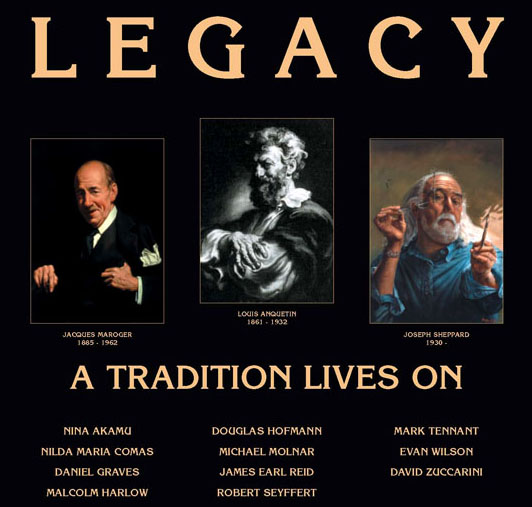
|
Exhibition Schedule 2005 University of Maryland, University College: Opening Exhibition April 3 – June 28, 2005 Midwest Museum of American Art, Elkhart, IN: July 22 – Sept. 18, 2005 Westervelt-Warner Museum of American Art: Oct. 7 – Nov. 14 Appleton Museum of Art: Dec. 2 – Feb. 26, 2006 2006 Appleton Museum of Art: Until Feb. 26 Picker Art Gallery, Colgate Univ. March 20 – April 30 May – July 2006 Available J. Wayne Stark Galleries, Texas A&M Univ. Aug. 24 – October 29 Jule Collins Smith Museum, Auburn University: November 06 – January 07, 2007 2007 February – August 2007 Available Butler Institute of American Art Satelite Gallery, Salem, Ohio: June 9 - August 11 Springfield Museum of Art, OH: September 1 – October 27.
If you would like more information about hosting LEGACY, A Tradition Lives On, please e-mail us at: EVANWILSON@ADELPHIA.NET |
|
|
This exhibition, and companion book with the same name, tells the story of an artistic legacy handed down through four generations. The creator of this particular legacy was the French artist Louis Anquetin (1861–1932). He was the leader of a group of students who were studying under Fernand Cormon in Paris, and he was considered one of the most promising students in that group. His friends were Henri de Toulouse-Lautrec, Vincent van Gogh, and Emile Bernard. Anquetin and Bernard invented a new style that was dubbed “cloisonnism” and influenced many of the other neoimpressionists. After some success and recognition, Anquetin made an abrupt turnabout in his career. He realized that the artistic training and contemporary materials of his day were much inferior to those of the old masters. He spent the rest of his life trying to find the lost secrets of their techniques and formulas. He studied anatomy to improve his drawing and made several chemical experiments to find the masters’ mediums, especially that of Peter Paul Rubens. The second generation to enter this legacy was Jacques Maroger (1884–1962) who came to study with Anquetin and eventually became his assistant. After years with Anquetin, Maroger decided to go into restoration in order to become closer to the old masters’ work, especially work that had not been cleaned or repainted. His efforts were rewarded when he became the technical director of the Laboratory of the Louvre Museum in Paris and president of the Restorers of France. In 1929, Maroger was credited with rediscovering the first oil painting medium of Jan Van Eyck. He presented this medium to his former teacher, Anquetin, and after using it, Anquetin replied in a letter that with this medium he would be able to paint at least one good painting before he died. Maroger arrived in America just before World War II and was asked to set up a European-style atelier at the Maryland Institute of Art in Baltimore, Maryland, where he would teach his old masters technique. Maroger gathered together a core group of talented students who became known as the Maroger group. In the late 1950s and 1960s, they showed together at the Grand Central Art Galleries in New York. One member of the Maroger group was Joseph Sheppard (b. 1930), who is the third link in this legacy. After graduating from the Maryland Institute of Art in 1953, he became artist-in-residence at Dickinson College in Carlisle, Pennsylvania, and soon after won a John Simon Guggenheim Fellowship that enabled him to travel to Europe for the first time. Maroger retired from the Maryland Institute, and, a few years later, Sheppard was asked to take his place teaching the Maroger method. Sheppard taught at the Institute for 15 years and had many talented students. That was over 25 years ago. Now some of his former students stay in touch. They are successful, in their midcareers, creating, teaching, and working in the mediums of painting, lithography, and sculpture. Making up the fourth generation, they are Nina Akamu, Nilda Maria, Comas, Daniel Graves, Malcolm Harlow, Douglas Hofmann, Michael Molnar, James Earl Reid, Robert Seyffert, Mark Tennant, Larry Dodd Wheeler, Evan Wilson, and David Zuccarini. The tradition lives on. |
|